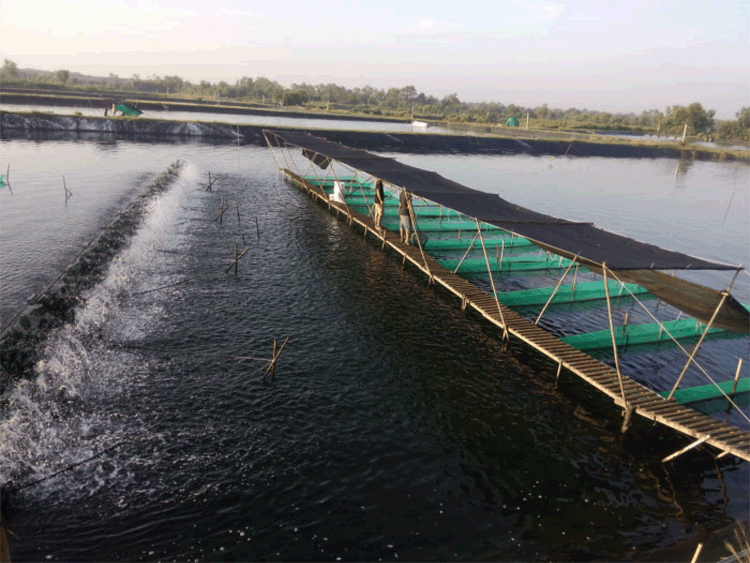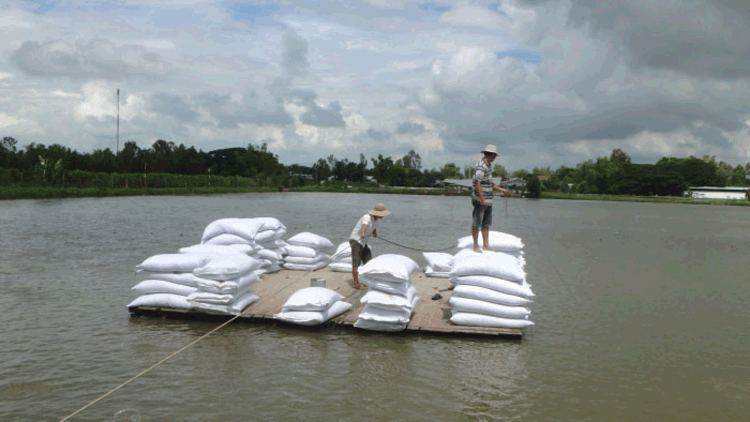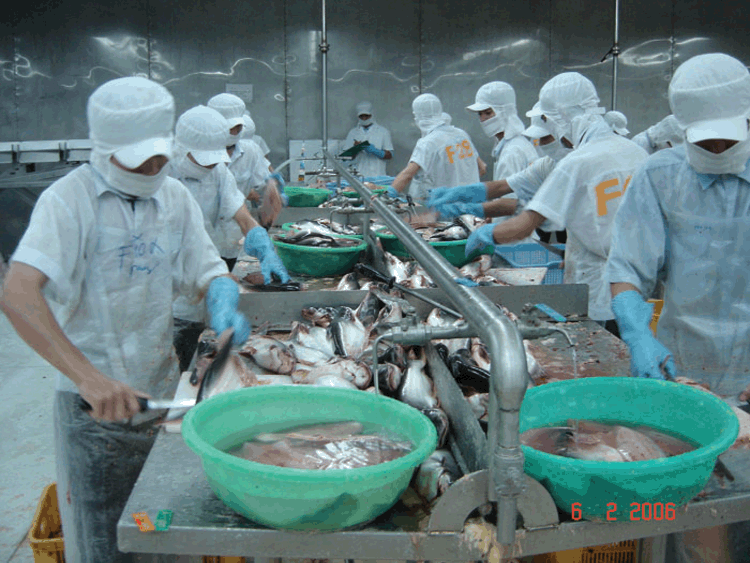Antibiotic resistance associated with aquaculture in Vietnam
Hoang Nam Kha Nguyen A , Thi Thu Hao Van B C and Peter J Coloe BA Faculty of Fisheries, Nong Lam University, Thu Duc District, Ho Chi Minh City, Vietnam
B School of Science, RMIT University, Bundoora West Campus, Bundoora, Vic. 3083, Australia
C Email: thithuhao.van@rmit.edu.au
Microbiology Australia 37(3) 108-111 https://doi.org/10.1071/MA16037
Published: 12 August 2016
The fishery sector is an important source of income, employment and food supply in Vietnam. In 2014, Vietnam was ranked the world’s fourth largest exporter and the third largest producer of farmed food fish. Vietnam seafood export has attained the value of over US$6.0 billion since 2011 and reached a peak of US$7.9 billion in 2014. However, many problems and diseases confront sustainable development of the fishery sector and overuse of antibiotics is considered a major challenge. Antibiotics are used in aquaculture for both therapeutic and prophylactic reasons. Various antimicrobials used in human medicine are also used for food animals even for non-therapeutic use. The use of antibiotics in health management of aquaculture farming is of great concern due to possible residues in aquatic products and in the development of antibiotic resistance. In 2005 the Vietnamese government first promulgated a list of medicines, chemicals and antibiotics that are banned or limited for use in aquaculture and this is regularly updated and amended to tackle the growing problem of antibiotic resistance.
The fishery sector in Vietnam
Fisheries is a key national economic sector that produces 4–5% GDP and 5–6% of the total national turnover of Vietnam. Aquaculture in Vietnam has changed from a self-sufficient sector in the early 1960s into a concentrated commodity production and this model has become the most important contributor in the fishery sector since 2007. In Vietnam, the Mekong River Delta in the south and the Red River Delta in the north have been the major areas for wild caught fishing as well as intensive aquaculture farming for decades. Aquaculture production in the Mekong Delta has contributed more than 70% of the country’s total production, in which catfish (fresh water) and black tiger and white leg shrimp (brackish water) are the three most important commercial species grown (Figures 1, 2). Since the 1990s, fishery products have been the third biggest export commodity of the country. Fishery exports earned over US$1 billion in 2000, US$3 billion in 2006, US$6 billion in 2011 and reached a peak of US$7.9 billion in 2014. Currently, Vietnamese fishery products are exported to more than 140 countries and territories in five continents. According to the Food and Agriculture Organisation of the United Nations (FAO), nearly 10% of the population in Vietnam obtains their main income from Fisheries. More than four million workers including a large proportion of women are employed in aquaculture and fishery activities (Figure 3).
Antibiotic resistance in aquaculture in Vietnam
In Vietnam, only limited studies on antibiotic uses and resistance in aquaculture were conducted and/or published before 2005. A study on antibiotic residues and resistance against Norfloxacin (NOR), Oxolinic acid (OXO), Trimethoprim (TRI) and Sulfamethoxazole (SUL) has been conducted in four shrimp farming locations (Thai Binh, Nam Dinh, Can Gio-Ho Chi Minh City and Ca Mau provinces) in mangrove areas in Vietnam in 20031. The results showed the presence of antibiotic residues and a high incidence of bacterial resistance to the four antibiotics observed in these shrimp ponds in different mangrove areas in Vietnam. Another study on antibiotic resistance of 123 bacterial isolates (from water, sediment and different fish farms (catfish, tilapia, common carp and gourami) in five provinces in the Mekong Delta) found that 90% of the isolates were resistant to Tetracycline (TET), 76% to Ampicillin (AMP), 100% to Chloramphenicol (CHL), 65% to Nitrofurantoin (NIT) and 89% to Trimethoprim-Sulphamethoxazole (SXT).
A number of extensive research projects on antibiotic resistance of commensal bacteria from several aquaculture species have been conducted by our groups. In 2003, a study on the resistance of 101 isolates (belonging to the family Enterobacteriaceae) from frozen catfish of the Mekong Delta showed high frequencies of resistance (80–100%) to Oxytetracycline (OTE), CHL, Streptomycin (STR), SXT and AMP (unpublished data). The levels of multiple resistance were also high, of which 100% of isolates were resistant to at least four antibiotics. A research study published in 2005 reported the resistance of 92 isolates (including Enterobacteriaceae (49.1%), Pseudomonas spp. (35.2%) and Vibrionaceae (15.7%) families) from three catfish farms in the Mekong Delta2. Rather high incidences (20–60%) of resistance to OTE, CHL, SXT, NIT, Nalidixic acid (NAL) and AMP were observed. The multiple antibiotic resistance (MAR) index values indicated that the three farms corresponded to high-risk exposed-antibiotic sources. In a recent publication, a larger collection of samples (catfish, water and sediment) was collected from 50 catfish culture ponds (belonging to 15 catfish intensive farms) in the Mekong Delta, Vietnam3. All 116 Pseudomonas spp. and 92 Aeromonas spp. isolates recovered from these samples were tested for their resistance to 13 antimicrobial agents belonging to eight families. High levels of resistance to AMP, SXT, and NAL were observed. Lower frequencies of resistance occurred against Ciprofloxacin (CIP), NOR, TET, Doxycycline (DOX), Gentamycin (GEN), Neomycin (NEO), STR, and Kanamycin (KAN). The percentages of multiple resistance (resistance to three or more antimicrobial classes) was 96.6% for Pseudomonas and 61.9% for Aeromonas spp. The MAR indices showed that Pseudomonas and Aeromonas isolates were high-risk sources of contamination where antibiotics were commonly used. The level of resistance to CHL and NIT was still high despite these antibiotics being banned for use in aquaculture in Vietnam since 2005, and this resistance is possibly due to the co-transfer of resistance genes. Our recent study on the resistance of 167 Vibrio spp. isolated from blood cockles (16 farms of the six provinces in the Mekong Delta) showed a low incidence of resistance to nine tested antibiotics (TET, NAL, NOR, CIP, SXT, NIT, CHL, STR, KAN), with a high level of resistance to AMP only. Unfortunately, very high levels of resistance of bacteria in aquaculture environments or products have also been reported in many countries which have intensive aquaculture activities such as China4, USA5, Thailand6, India7, Indonesia8, Australia9, Italy10 and Chile11 implying the heavy use of antibiotics in aquaculture worldwide and this provides a warning on the effects of antibiotic usage in aquatic ecosystems, and the world wide emergence of antibiotic resistance in aquatic bacteria.
Integrons and the transferability of antibiotic resistant genes
In bacteria, horizontal gene transfer is the principle mechanism responsible for the spread of antibiotic resistance genes12. Horizontal gene transfer is facilitated by mobile genetic elements such as conjugative plasmids, transposons, and phages13. Integrons are not themselves mobile elements but are associated with mobile genetic elements (transposons or conjugative plasmids) enabling efficient intra- or interspecies transmission14. In Vietnam, studies on integrons and resistance gene transfer mechanisms have been conducted in clinical isolates1,15–19. However, very limited studies have been published on non-human isolates such as food-borne pathogens20, animal pathogens19 and catfish pathogens21. Recently we have done an extensive study on integrons and the transferability of antibiotic resistant genes of commensal bacteria in catfish aquaculture in Vietnam3. We found that the commensal isolates of catfish harbour a pool of mobile genetic elements such as plasmids and integrons, which contain various antibiotic resistance gene cassettes. Conjugation and transformation experiments demonstrated the successful transfer of all or part of the resistance phenotypes of isolates to the recipient strains of different genera and sources. Class 1 integrons associated with plasmids have facilitated the emergence and dissemination of antibiotic resistance in aquaculture environments. The transformation and conjugation experiments also indicated that CHL resistance phenotype was co-transferred in association with SXT, AMP, TET resistance phenotypes. In addition, the CHL resistance genes (catB) have often been associated with class 1 integrons, therefore, the co-selection is important for CHL resistance dissemination. This suggests that, in the absence of chloramphenicol selection pressure, CHL resistance is co-transferred and maintained due to gene linkage to genes encoding resistance to antimicrobials that are widely used in food animals or aquaculture22. The other studies worldwide also indicate that aquatic environments or products are reservoirs of antibiotic resistance and class 1 integrons have facilitated the dissemination of antibiotic resistant genes such as in the USA23, China24, Thailand25, Northern Europe and North America26, Europe, Japan and the USA27, and Japan28.
Conclusion
The high frequencies of resistance observed in aquaculture bacterial isolates in Vietnam, and in worldwide aquatic environmental and product isolates, reflect the global spread of resistance due to extensive use of antibiotics in aquaculture. Aquaculture resident bacteria could serve as a reservoir of resistant genes if they harbour a pool of mobile genetic elements that can readily be transferred intra- and interspecies.
References
[1] Le, T.X. et al. (2005) Antibiotic resistance in bacteria from shrimp farming in mangrove areas. Sci. Total Environ. 349, 95–105.| Antibiotic resistance in bacteria from shrimp farming in mangrove areas.Crossref | GoogleScholarGoogle Scholar | 1:CAS:528:DC%2BD2MXhtVKhurzF&md5=b4bcaea1b5a8debde6775ec84a902655CAS | 16198672PubMed |
[2] Sarter, S. et al. (2007) Antibiotic resistance in Gram-negative bacteria isolated from farmed catfish. Food Contr. 18, 1391–1396.
| Antibiotic resistance in Gram-negative bacteria isolated from farmed catfish.Crossref | GoogleScholarGoogle Scholar | 1:CAS:528:DC%2BD2sXkvFOhsrY%3D&md5=a8c80fed4aedc64098fa1819a9df548dCAS |
[3] Nguyen, H.N.K. et al. (2014) Molecular characterization of antibiotic resistance in Pseudomonas and Aeromonas isolates from catfish of the Mekong Delta, Vietnam. Vet. Microbiol. 171, 397–405.
| Molecular characterization of antibiotic resistance in Pseudomonas and Aeromonas isolates from catfish of the Mekong Delta, Vietnam.Crossref | GoogleScholarGoogle Scholar | 1:CAS:528:DC%2BC2cXksFWmtLY%3D&md5=924e2f13583b3be15e8608986f114c56CAS |
[4] Su, H.-C. et al. (2011) Occurrence of antibiotic resistance and characterization of resistance genes and integrons in Enterobacteriaceae isolated from integrated fish farms in south China. J. Environ. Monit. 13, 3229–3236.
| Occurrence of antibiotic resistance and characterization of resistance genes and integrons in Enterobacteriaceae isolated from integrated fish farms in south China.Crossref | GoogleScholarGoogle Scholar | 21975604PubMed |
[5] McPhearson, R.M. et al. (1991) Antibiotic resistance in Gram-negative bacteria from cultured catfish and aquaculture ponds. Aquaculture 99, 203–211.
| Antibiotic resistance in Gram-negative bacteria from cultured catfish and aquaculture ponds.Crossref | GoogleScholarGoogle Scholar |
[6] Kitiyodom, S. et al. (2010) Characterization of antibiotic resistance in Vibrio spp. isolated from farmed marine shrimps (Penaeus monodon). FEMS Microbiol. Ecol. 72, 219–227.
| Characterization of antibiotic resistance in Vibrio spp. isolated from farmed marine shrimps (Penaeus monodon).Crossref | GoogleScholarGoogle Scholar | 1:CAS:528:DC%2BC3cXlvVamsLs%3D&md5=97383ad28008757b879986209254bdf8CAS | 20236324PubMed |
[7] Vivekanandhan, G. et al. (2002) Antibiotic resistance of Aeromonas hydrophila isolated from marketed fish and prawn of South India. Int. J. Food Microbiol. 76, 165–168.
| Antibiotic resistance of Aeromonas hydrophila isolated from marketed fish and prawn of South India.Crossref | GoogleScholarGoogle Scholar | 1:CAS:528:DC%2BD38Xis1yjs7w%3D&md5=89de83498ccc75375b34cf38d6aa4f8bCAS | 12038573PubMed |
[8] Yusop, Z. et al. (2009) Antibiotic resistance and plasmid profiling of Vibrio parahaemolyticus isolated from cockles in Padang, Indonesia. Int. Food. Res J. 16, 53–58.
[9] Akinbowale, O.L. et al. (2006) Antimicrobial resistance in bacteria isolated from aquaculture sources in Australia. J. Appl. Microbiol. 100, 1103–1113.
| Antimicrobial resistance in bacteria isolated from aquaculture sources in Australia.Crossref | GoogleScholarGoogle Scholar | 1:CAS:528:DC%2BD28XlvVamt7g%3D&md5=fdbc5af99f5f98e1cde8a1595801a1f5CAS | 16630011PubMed |
[10] Ottaviani, D. et al. (2001) Antimicrobial susceptibility of potentially pathogenic halophilic vibrios isolated from seafood. Int. J. Antimicrob. Agents 18, 135–140.
| Antimicrobial susceptibility of potentially pathogenic halophilic vibrios isolated from seafood.Crossref | GoogleScholarGoogle Scholar | 1:CAS:528:DC%2BD3MXmtV2mt74%3D&md5=8237150cde0f08cd64b5bae61a821a57CAS | 11516936PubMed |
[11] Miranda, C.D. and Zemelman, R. (2002) Antimicrobial multiresistance in bacteria isolated from freshwater Chilean salmon farms. Sci. Total Environ. 293, 207–218.
| Antimicrobial multiresistance in bacteria isolated from freshwater Chilean salmon farms.Crossref | GoogleScholarGoogle Scholar | 1:CAS:528:DC%2BD38XksFKlu7k%3D&md5=b2e08bdc3f0830dc3bedc60656b05aaaCAS |
[12] de la Cruz, F. and Davies, J. (2000) Horizontal gene transfer and the origin of species: lessons from bacteria. Trends Microbiol. 8, 128–133.
| Horizontal gene transfer and the origin of species: lessons from bacteria.Crossref | GoogleScholarGoogle Scholar | 1:STN:280:DC%2BD3c7ntlyhsg%3D%3D&md5=1b51c452dd38efc4adf67628aa13b9ddCAS | 10707066PubMed |
[13] Smets, B.F. and Barkay, T. (2005) Horizontal gene transfer: perspectives at a crossroads of scientific disciplines. Nat. Rev. Microbiol. 3, 675–678.
| Horizontal gene transfer: perspectives at a crossroads of scientific disciplines.Crossref | GoogleScholarGoogle Scholar | 1:CAS:528:DC%2BD2MXps1Kjtb0%3D&md5=8c7457358ff7c51c017cb863835d693bCAS | 16145755PubMed |
[14] Davies, J. and Davies, D. (2010) Origins and evolution of antibiotic resistance. Microbiol. Mol. Biol. Rev. 74, 417–433.
| Origins and evolution of antibiotic resistance.Crossref | GoogleScholarGoogle Scholar | 1:CAS:528:DC%2BC3cXhsVSqurnO&md5=3d04c26edb72d771282e9b1fe680d5feCAS | 20805405PubMed |
[15] Dalsgaard, A. et al. (1999) Cholera in Vietnam: changes in genotypes and emergence of class i integrons containing aminoglycoside resistance gene cassettes in Vibrio cholerae O1 strains isolated from 1979 to 1996. J. Clin. Microbiol. 37, 734–741.
| 1:CAS:528:DyaK1MXhsleitrc%3D&md5=7059b93448418e54b5bd3d85f1f7156cCAS | 9986842PubMed |
[16] Iversen, J. et al. (2003) Characterization of antimicrobial resistance, plasmids, and gene cassettes in Shigella spp. from patients in Vietnam. Microb. Drug Resist. 9, 17–24.
| Characterization of antimicrobial resistance, plasmids, and gene cassettes in Shigella spp. from patients in Vietnam.Crossref | GoogleScholarGoogle Scholar |
[17] Le, V. et al. (2015) Genetic characterization of three qnrS1-harbouring multidrug-resistance plasmids and qnrS1-containing transposons circulating in Ho Chi Minh City, Vietnam. J. Med. Microbiol. 64, 869–878.
| Genetic characterization of three qnrS1-harbouring multidrug-resistance plasmids and qnrS1-containing transposons circulating in Ho Chi Minh City, Vietnam.Crossref | GoogleScholarGoogle Scholar | 1:CAS:528:DC%2BC28Xpt1Klurc%3D&md5=3392af6d9dfbb68aa61280259ebda1c4CAS | 26272054PubMed |
[18] Naas, T. et al. (2000) Integron-located VEB-1 extended-spectrum β-lactamase gene in a Proteus mirabilis clinical isolate from Vietnam. J. Antimicrob. Chemother. 46, 703–711.
| Integron-located VEB-1 extended-spectrum β-lactamase gene in a Proteus mirabilis clinical isolate from Vietnam.Crossref | GoogleScholarGoogle Scholar | 1:CAS:528:DC%2BD3cXosVGmsL4%3D&md5=71199ccda417a3ba4352cc960836b8a3CAS | 11062188PubMed |
[19] Vo, A.T.T. et al. (2010) Antimicrobial resistance, class 1 integrons, and genomic Island 1 in Salmonella isolates from Vietnam. PLoS One 5, e9440.
| Antimicrobial resistance, class 1 integrons, and genomic Island 1 in Salmonella isolates from Vietnam.Crossref | GoogleScholarGoogle Scholar |
[20] Van, T.T.H. et al. (2007) Antibiotic resistance in food-borne bacterial contaminants in Vietnam. Appl. Environ. Microbiol. 73, 7906–7911.
| Antibiotic resistance in food-borne bacterial contaminants in Vietnam.Crossref | GoogleScholarGoogle Scholar |
[21] Dung, T.T. et al. (2009) IncK plasmid-mediated tetracycline resistance in Edwardsiella ictaluri isolates from diseased freshwater catfish in Vietnam. Aquaculture 295, 157–159.
| IncK plasmid-mediated tetracycline resistance in Edwardsiella ictaluri isolates from diseased freshwater catfish in Vietnam.Crossref | GoogleScholarGoogle Scholar | 1:CAS:528:DC%2BD1MXhtVKmu7%2FL&md5=9cc23c742f5935dc738ba0bc05c2c235CAS |
[22] Bischoff, K.M. et al. (2005) The chloramphenicol resistance gene cmlA is disseminated on transferable plasmids that confer multiple-drug resistance in swine Escherichia coli. FEMS Microbiol. Lett. 243, 285–291.
| The chloramphenicol resistance gene cmlA is disseminated on transferable plasmids that confer multiple-drug resistance in swine Escherichia coli.Crossref | GoogleScholarGoogle Scholar | 1:CAS:528:DC%2BD2MXmsVGisg%3D%3D&md5=ae09ddab69f91803aabe748b8cb377aaCAS | 15668031PubMed |
[23] Nawaz, M. et al. (2010) Detection and characterization of virulence genes and integrons in Aeromonas veronii isolated from catfish. Food Microbiol. 27, 327–331.
| Detection and characterization of virulence genes and integrons in Aeromonas veronii isolated from catfish.Crossref | GoogleScholarGoogle Scholar | 1:CAS:528:DC%2BC3cXjtFyitrk%3D&md5=4d7348ef547fbc43d73e49489530ce40CAS | 20227596PubMed |
[24] Chen, B. et al. (2011) Class 1 integrons, selected virulence genes, and antibiotic resistance in Escherichia coli isolates from the Minjiang River, Fujian Province, China. Appl. Environ. Microbiol. 77, 148–155.
| Class 1 integrons, selected virulence genes, and antibiotic resistance in Escherichia coli isolates from the Minjiang River, Fujian Province, China.Crossref | GoogleScholarGoogle Scholar | 1:CAS:528:DC%2BC3MXisVOqtbs%3D&md5=e62c12309788bbe05541659e6993131aCAS | 21057021PubMed |
[25] Agersø, Y. and Petersen, A. (2007) The tetracycline resistance determinant Tet 39 and the sulphonamide resistance gene sulII are common among resistant Acinetobacter spp. isolated from integrated fish farms in Thailand. J. Antimicrob. Chemother. 59, 23–27.
| The tetracycline resistance determinant Tet 39 and the sulphonamide resistance gene sulII are common among resistant Acinetobacter spp. isolated from integrated fish farms in Thailand.Crossref | GoogleScholarGoogle Scholar | 17095527PubMed |
[26] Schmidt, A.S. et al. (2001) Characterization of class 1 integrons associated with R-plasmids in clinical Aeromonas salmonicida isolates from various geographical areas. J. Antimicrob. Chemother. 47, 735–743.
| Characterization of class 1 integrons associated with R-plasmids in clinical Aeromonas salmonicida isolates from various geographical areas.Crossref | GoogleScholarGoogle Scholar | 1:CAS:528:DC%2BD3MXksFCiurs%3D&md5=c25d5479ecd9466558cdc891eb14e374CAS | 11389105PubMed |
[27] L’Abée-Lund, T.M. and Sørum, H. (2001) Class 1 integrons mediate antibiotic resistance in the fish pathogen Aeromonas salmonicida worldwide. Microb. Drug Resist. 7, 263–272.
| Class 1 integrons mediate antibiotic resistance in the fish pathogen Aeromonas salmonicida worldwide.Crossref | GoogleScholarGoogle Scholar | 11759088PubMed |
[28] Ahmed, A.M. et al. (2015) Seafood as a reservoir of Gram-negative bacteria carrying integrons and antimicrobial resistance genes in Japan. Biomed. Environ. Sci. 28, 924–926.
| 26777914PubMed |
Biographies
Dr Hoang Nam Kha Nguyen is a lecturer in Department of Aquatic Product Processing at the Faculty of Fisheries at Nong Lam University. His research interests are aquaculture commensal bacteria and molecular biology.
Dr Thi Thu Hao Van is a Reseach Fellow in the School of Science, RMIT University. Her research interests are antibiotic resistance and virulence of bacterial pathogens, the development of bacteria from gut microbiota for use as probiotics, identifying the cause of disease in farm animals, and the development of vaccines against the pathogens causing these diseases.
Professor Peter J Coloe is Pro Vice-Chancellor, College of Science, Engineering and Health, RMIT University and is a Fellow of ASM. His research interests are in vaccines and disease diagnostics and novel ways to control disease and to deliver vaccine antigens.





